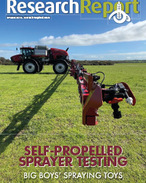This article is 9 years old. Images might not display.
DAFWA is exploring the use of smart technology to boost surveillance and crop diagnosis, as part of a suite of Boosting Grains Research and Development Flagship projects made possible by Royalties for Regions funding.
One project aim is to develop a smart phone app that will inform growers, while they are still in the paddock, whether or not to treat for pests and diseases.
Another is to develop an early warning detection model for pests and diseases of grain crops.
A third output is to incorporate the early warning detection model into a Smart Trap array to improve treatment responses and aid surveillance for common and exotic pests and diseases.
Project manager Dusty Severtson said the new tools would assist grain growers struggling to monitor crops over increasingly large farming properties.
Severtson said the smart phone app was being developed to simplify and accelerate surveying for cabbage aphid in canola, as a model for future applications, while simultaneously determining treatment threshold levels.
“Assessing crops is typically time and labour intensive, requiring growers and consultants to inspect plants in many locations to ensure accuracy when measuring the infestation level relative to threshold levels,” he said.
“This app aims to enable the grower to sample crops and merely tap whether cabbage aphid is ‘present’ or ‘not present’ on a smart phone, which will calculate whether the threshold has been reached and determine if treatment is required.”
The aim is to synchronise the smart phone app with the department’s MyPestGuide online tool to map the location of the canola aphids in a paddock, which will assist growers to tailor treatment options spatially.
“This feature will help reduce blanket spraying, saving growers’ time and money,” Dr Severtson said.
The other sub-project will also draw on the use of Loop-mediated isothermal AMPlification (LAMP) technology, used to detect plant viruses at a molecular level, to develop a method for rapid, sensitive and reliable in-field diagnosis.
Department plant virologist Brenda Coutts, who heads the project component, said field-based LAMP technology was being employed to detect Beet western yellows virus in the green peach aphid vector in canola, as a model for future uses.
“Being able to detect the virus within the vector will provide growers with a pre-season indication of virus risk for particular regions and the opportunity to prepare in advance to protect yields,” Coutts said.
The final sub-project will use LAMP technology to establish a Smart Trap array across the Grainbelt, to provide an early warning system for pests and diseases, in association with traditional diagnosis tools.
“The Smart Trap array will aid pest and disease forecasting and improve early detection and diagnosis of endemic crop pests and diseases to improve crop production and profitability,” Coutts said.
“It will also be a valuable tool to assist grains biosecurity, aiding surveillance and identification of exotic threats to the State’s valuable grains crops.”























